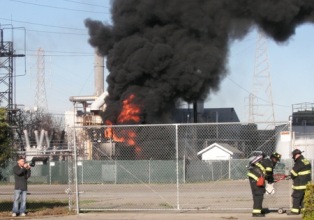Causes of accidents and failures in substations and electrical networks
The most important duty of substation workers is to ensure the reliable operation of electrical equipment and uninterrupted power supply to consumers. All cases of violation of the norm operating modes of substations (automatic shutdown of the equipment when short closures, wrong actions of personnel, interruptions in power supply, users, etc.) are considered accidents or work failures, depending on their nature, the degree of damage to the equipment and the consequences to which they led.
Substation accidents can occur as a result of unexpected equipment failures, equipment malfunctions from possible overvoltages and electric arc effects, malfunctions in the operation of relay protection devices, automation, secondary switching devices, wrong actions of personnel (operational, repair, production services).

Causes of unexpected equipment failures.are usually poor-quality installation and repair of equipment (for example, damage to switches due to poor adjustment of the transmission of precision mechanisms and drives), unsatisfactory equipment operation, unsatisfactory care, for example for contact links, which leads to their overheating with subsequent interruption of the circuit of the working current and the occurrence of a short circuit, defects in the design and technology of equipment production (factory defects), natural aging and forced wear of the insulation. For example, systematically exceeding the temperature of the transformer windings above the permissible one by 6 OS halves the period of possible use of its insulation.
The causes of disturbances in the operation of electrical installations can be lightning and switching surges, thus damaging the insulation of transformers, switches, disconnectors and other equipment. Excessive pollution and moisture of the insulation contribute to its overlapping and destruction.
Single-phase ground faults in networks 6 — 35 kV, accompanied by burning of grounding arcs (due to insufficient compensation capacitive currents), lead to overvoltages, breakdowns in the electrical insulation of machines and devices and the direct impact of grounding arcs to the destruction of insulators, melting of busbars, burning of secondary switching circuits in switchgears, etc.
Causes of failures and operation of relay protection devices, automation equipment and secondary switching are as follows: malfunctions of electrical and mechanical parts of the relay, damage to contact connections, broken cores of control cables, control circuits, etc., wrong selection or untimely change of relay settings and characteristics, installation errors and defects in relay protection and automation circuits, improper actions of personnel when maintaining relay protection and automation devices.
Any cause can lead to tripping failure or non-selective tripping of equipment during short circuit and has severe consequences until the development of local failures in system.
The reasons for the wrong actions of the personnel when performing the switches in most cases are violations of operational discipline, neglecting the requirements of the rules for technical operation, insufficient knowledge of the instructions, carelessness, lack of control over one's own actions, etc.
The above are only the main, most frequently repeated causes of accidents and many others that occurred during work, electrical equipment for substations and electrical networks are not specified. And although the causes of accidents sometimes seem random, the probability of their recurrence is still quite high. Therefore, all cases of Avarka are thoroughly investigated, studied and measures are taken to exclude their recurrence.
Accidents with substations are relatively rare, but extremely significant in their consequences.They are eliminated mainly by the action of special automatic devices, in other cases they are eliminated by the actions of service personnel.
Elimination of accidents by operational personnel consists of: v perform a switchnecessary to isolate damaged equipment and prevent the development of an accident, eliminate the danger to personnel, in the localization and elimination of outbreaks of outbreaks in the event of their occurrence, through restoration in the shortest time of power supply to users, when clarifying the condition of the equipment, disconnected from the network, and taking measures to turn it on or take it out for repair.
For operational personnel, responding to emergency situations is a difficult task, the solution of which is related to the mobilization in a short period of time of all their knowledge, skills and experience. The difficulty in decision-making is complicated by the consciousness of the person responsible for the correctness of the decisions made in an unexpected and sometimes difficult emergency situation, when the staff, experiencing emotional tension, must act impeccably, clearly and quickly. Under these conditions, self-control of the personnel, self-control, concentration and concentration of attention on the most important thing, they are the key to successful elimination of the accident.
